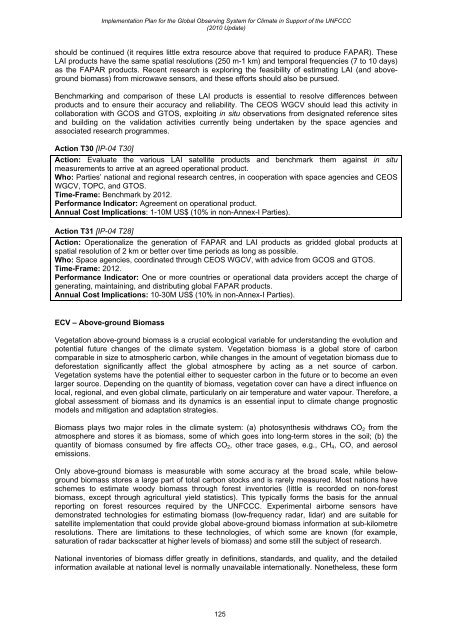GCOS Implementation Plan - WMO
GCOS Implementation Plan - WMO
GCOS Implementation Plan - WMO
You also want an ePaper? Increase the reach of your titles
YUMPU automatically turns print PDFs into web optimized ePapers that Google loves.
<strong>Implementation</strong> <strong>Plan</strong> for the Global Observing System for Climate in Support of the UNFCCC<br />
(2010 Update)<br />
should be continued (it requires little extra resource above that required to produce FAPAR). These<br />
LAI products have the same spatial resolutions (250 m-1 km) and temporal frequencies (7 to 10 days)<br />
as the FAPAR products. Recent research is exploring the feasibility of estimating LAI (and aboveground<br />
biomass) from microwave sensors, and these efforts should also be pursued.<br />
Benchmarking and comparison of these LAI products is essential to resolve differences between<br />
products and to ensure their accuracy and reliability. The CEOS WGCV should lead this activity in<br />
collaboration with <strong>GCOS</strong> and GTOS, exploiting in situ observations from designated reference sites<br />
and building on the validation activities currently being undertaken by the space agencies and<br />
associated research programmes.<br />
Action T30 [IP-04 T30]<br />
Action: Evaluate the various LAI satellite products and benchmark them against in situ<br />
measurements to arrive at an agreed operational product.<br />
Who: Parties’ national and regional research centres, in cooperation with space agencies and CEOS<br />
WGCV, TOPC, and GTOS.<br />
Time-Frame: Benchmark by 2012.<br />
Performance Indicator: Agreement on operational product.<br />
Annual Cost Implications: 1-10M US$ (10% in non-Annex-I Parties).<br />
Action T31 [IP-04 T28]<br />
Action: Operationalize the generation of FAPAR and LAI products as gridded global products at<br />
spatial resolution of 2 km or better over time periods as long as possible.<br />
Who: Space agencies, coordinated through CEOS WGCV, with advice from <strong>GCOS</strong> and GTOS.<br />
Time-Frame: 2012.<br />
Performance Indicator: One or more countries or operational data providers accept the charge of<br />
generating, maintaining, and distributing global FAPAR products.<br />
Annual Cost Implications: 10-30M US$ (10% in non-Annex-I Parties).<br />
ECV – Above-ground Biomass<br />
Vegetation above-ground biomass is a crucial ecological variable for understanding the evolution and<br />
potential future changes of the climate system. Vegetation biomass is a global store of carbon<br />
comparable in size to atmospheric carbon, while changes in the amount of vegetation biomass due to<br />
deforestation significantly affect the global atmosphere by acting as a net source of carbon.<br />
Vegetation systems have the potential either to sequester carbon in the future or to become an even<br />
larger source. Depending on the quantity of biomass, vegetation cover can have a direct influence on<br />
local, regional, and even global climate, particularly on air temperature and water vapour. Therefore, a<br />
global assessment of biomass and its dynamics is an essential input to climate change prognostic<br />
models and mitigation and adaptation strategies.<br />
Biomass plays two major roles in the climate system: (a) photosynthesis withdraws CO 2 from the<br />
atmosphere and stores it as biomass, some of which goes into long-term stores in the soil; (b) the<br />
quantity of biomass consumed by fire affects CO 2 , other trace gases, e.g., CH 4 , CO, and aerosol<br />
emissions.<br />
Only above-ground biomass is measurable with some accuracy at the broad scale, while belowground<br />
biomass stores a large part of total carbon stocks and is rarely measured. Most nations have<br />
schemes to estimate woody biomass through forest inventories (little is recorded on non-forest<br />
biomass, except through agricultural yield statistics). This typically forms the basis for the annual<br />
reporting on forest resources required by the UNFCCC. Experimental airborne sensors have<br />
demonstrated technologies for estimating biomass (low-frequency radar, lidar) and are suitable for<br />
satellite implementation that could provide global above-ground biomass information at sub-kilometre<br />
resolutions. There are limitations to these technologies, of which some are known (for example,<br />
saturation of radar backscatter at higher levels of biomass) and some still the subject of research.<br />
National inventories of biomass differ greatly in definitions, standards, and quality, and the detailed<br />
information available at national level is normally unavailable internationally. Nonetheless, these form<br />
125
















